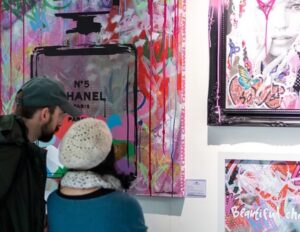After refining and thinking my curation, I became interested in the art market. I had attended the Edinburgh Art Fair, where I was able to admire the work of many artists. However, among the many artworks, I found that they were exhibited for a surprisingly consistent purpose – to increase art sales. As a result, the fair’s artworks were labeled as commercial. A wide array of artworks were placed on the walls as merchandise waiting to be selected and purchased by buyers.
 As a result, many of the works of art here are similar in presentation, with little color contrast and a “pleasing” painting style. Artworks have become commercialized and lack the artist’s own emotional expression of art.
As a result, many of the works of art here are similar in presentation, with little color contrast and a “pleasing” painting style. Artworks have become commercialized and lack the artist’s own emotional expression of art.
Based on this, I am passionate about : “Have the art works of the 21st century taken on the wings of ‘finance’? ” “I am not really interested in art,” (Hans, 2002) explains the founder of a now defunct art investment fund. “It is simply a commodity, which . . . It is simply a commodity, which . . produces substantial returns for investors.” (Noah, 2014) Art has gradually emerged in the market as a tool for traders to make money, with a “commodified” image. On the one hand, “everyone is an artist” has become the slogan for the artistic atmosphere in the 21st century, bridging the distance between life and art, and gradually bringing art down to the masses. On the other hand,It has also brought art and people closer together.
However, our enjoyment of art’s “populist” character has gradually turned art into “secularized“. Art is both a vehicle for conspicuous consumption and a carrier of hidden assets. It is closely allied with commerce. For one thing, it promotes the development of the art market and makes more people pay attention to and participate in art. It raises the aesthetic interest of the public.;Conversely, for another , in the face of the pressure brought by the market, artworks give up artistic expression and choose to cater to the commercial market.
For the fair, perhaps its own purpose is to increase sales. It is supposed to be an expression of the combination of commerce and art. Nevertheless, for curators, there are still implications to explore. As curators, when choosing artworks, should we focus on catering to the audience’s perspective or reflecting the artist’s creative emotions? How to find a balance between the two? This will be a point of interest for me to continue learning and reflecting on.
Reference
1. Abbing, Hans. Why Are Artists Poor? The Exceptional Economy of the Arts.Amsterdam: Amsterdam University Press, 2002.
2.Horowitz, Noah. Art of the Deal: Contemporary Art in a Global Financial Market. Princeton: Princeton University Press, 2014. https://doi-org.ezproxy.is.ed.ac.uk/10.1515/9781400836444


Leave a Reply